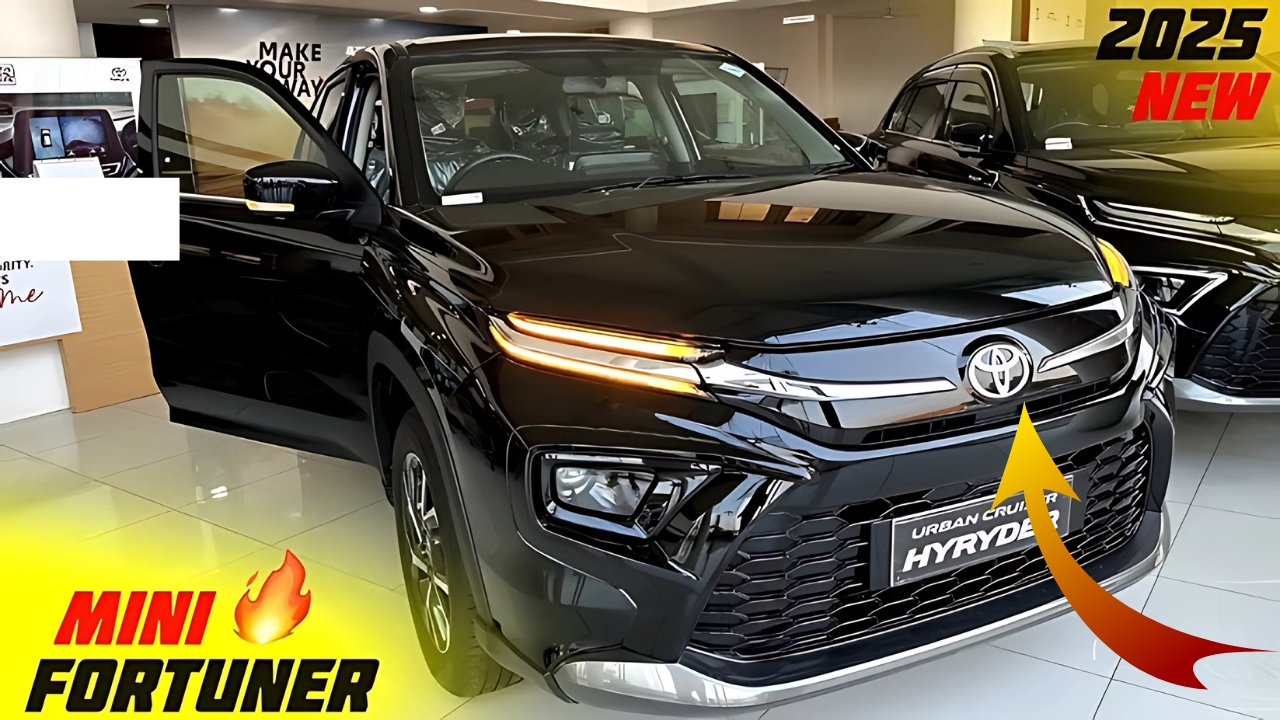Toyota Hyryder : When Toyota launched the Urban Cruiser Hyryder in mid-2022, auto enthusiasts quickly observed a dazzling similarity—this compact SUV bears notable design influences from its pricier sibling, the Fortuner.
This intentional design choice has established an appealing value proposition in India’s competitive SUV landscape, offering Fortuner-like aesthetics at about one-third the price.
The front fascia of the Hyryder is where this connection to Toyota’s flagship SUV is most apparent.
Boasting a prominent chrome-accented grille, it has the same horizontal slats arranged in the signature Toyota pattern that has become synonymous with more upscale models.
The sharply designed headlamp clusters, complete with distinctive LED daytime running lights, reflect the aggressive styling cues that give the Fortuner its commanding presence on the road.
“The first time I spotted a Hyryder at dusk, I thought it was a new compact version of the Fortuner,” shares Vikram Desai, proud owner of a 2019 Fortuner.
“I only realized my mistake when it approached. Toyota has brilliantly managed to transfer their premium design elements into this smaller creation.”
This visual connection is further extended along the Hyryder’s silhouette, featuring well-defined wheel arches and a subtly rising beltline that evoke the larger SUV’s shape in a streamlined manner.
Functionally styled roof rails add to this familial look.
Even the alloy wheels on the higher-tier Hyryder variants resemble those of certain Fortuner editions, showcasing a multi-spoke design with sophisticated machined surfaces that typically aren’t found in the sub-₹20 lakh segment.
Toyota Hyryder: Premium Features Made Accessible
The design resemblances do not stop at the exterior. Step inside the cabin, and you’ll find several elements reminiscent of the Fortuner, though the materials reflect the difference in pricing.
A layered dashboard with horizontal lines conveys a clear lineage to the more expensive Toyota SUVs.
The steering wheel is a tad smaller, but its controls and contours echo those found in the Fortuner.
Sanjay Krishnan, who opted for a Hyryder after comparing it with various competitors, remarks: “Having spent time in my colleague’s Fortuner, I instantly recognized certain design features—the door handle style, the center console layout, and even those little window switch panels.
Though they’ve been crafted with different cost targets in mind, the overall design philosophy feels connected.”
Higher trims of the Hyryder come equipped with ventilated front seats, a panoramic sunroof, and a 360-degree camera—a collection of features that were traditionally restricted to vehicles with a significantly higher price tag.
This accessibility of premium features significantly enhances the value for buyers looking for amenities similar to those of the Fortuner without the corresponding financial commitment.
Toyota Hyryder: Smart Engineering Tailored for Appeal
Underneath its Fortuner-inspired exterior, the Hyryder features engineering decisions tailored for its target price and intended use.
Opting for a monocoque structure—shared with Maruti Suzuki as part of their collaboration—rather than the Fortuner’s ladder-frame construction and off-road features is a sensible choice by Toyota.
This shared platform is what enables the attractive starting price of around ₹10.5 lakh (ex-showroom), while still providing a comfortable driving experience suited for urban environments.
The availability of both mild hybrid and strong hybrid powertrains—options not present in the Fortuner—actually offer the Hyryder some technological advantages over its more expensive cousin.
Dr. Anand Kulkarni, an automotive tech consultant, explains: “Toyota has been quite strategic here. They’ve leveraged the Fortuner’s aspirational design while implementing more contemporary, efficiency-oriented powertrains.
The hybrid system especially represents a leap in technology compared to what’s accessible in the Fortuner, despite the notable price difference.”
Toyota Hyryder: Strategic Market Positioning
Toyota’s approach with the Hyryder showcases insightful brand management—utilizing the established visual identity of their flagship SUV to boost the appeal of their entry into the hot compact SUV segment.
This strategy resonates particularly well with Indian consumers who are mindful of value and appreciate recognizable premium design traits.
“Initially, we were considering the Hyundai Creta and Kia Seltos,” shares Priya Mehta, who purchased a hybrid Hyryder in December 2022.
“The resemblance to the Fortuner significantly influenced our choice—it has a road presence that many compact SUVs simply lack.
Some relatives even mistook it for a far more expensive vehicle, which, I’ll admit, feels satisfyingly good.”
For those who admire the Fortuner’s striking aesthetics but find its ₹35-50 lakh price bracket out of reach, the Hyryder provides an attractive compromise.
It essentially offers around 70% of the visual appeal at a fraction of the cost—30% to be exact. This compelling value proposition accounts for the increasing numbers of these vehicles seen on Indian roads, despite the stiff competition from established players like Hyundai, Kia, and Maruti Suzuki.
As Indian buyers continue to seek vehicles that maximize perceived worth while minimizing actual costs, the Hyryder’s Fortuner-inspired design may just mark Toyota’s smartest market maneuver in recent years.
